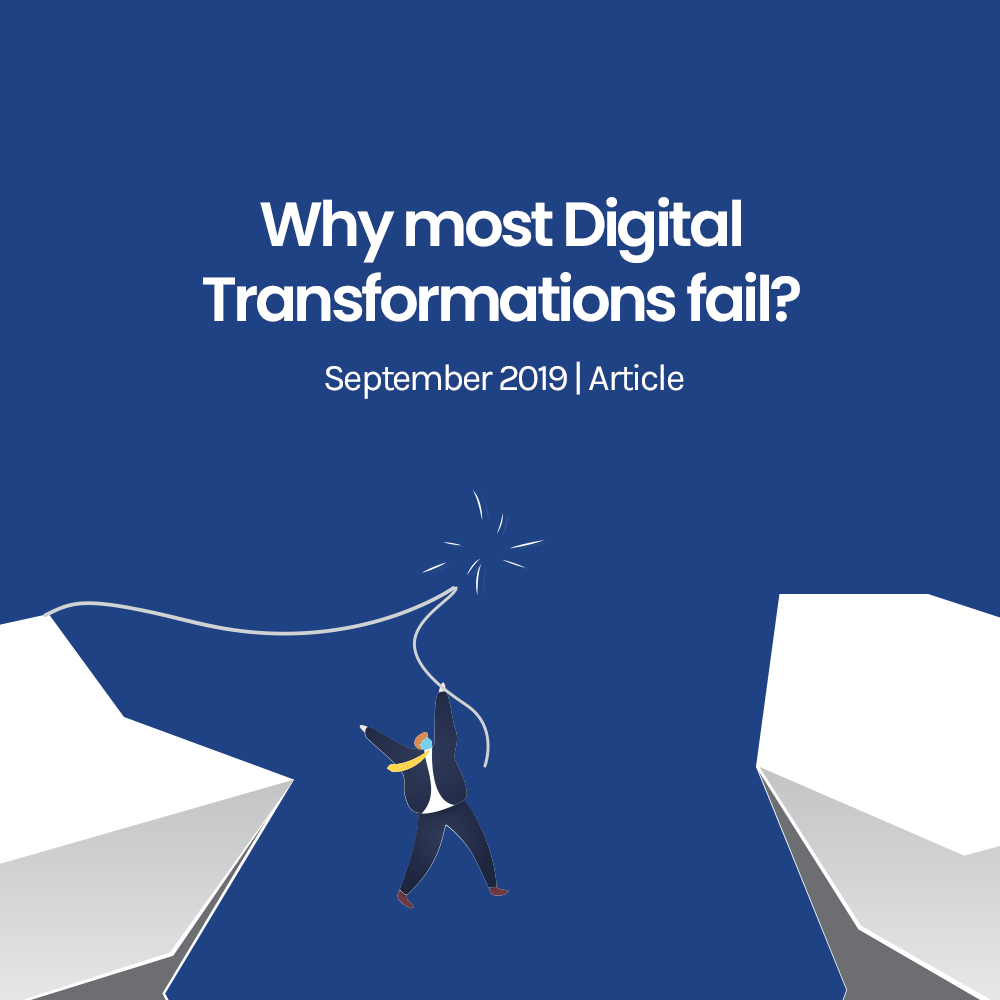

The ‘overused’ and ‘oversold’ digital transformation phenomenon has been the mainstay of all trends across all industries for at least the past decade and seems to be still on the rise with 70% of global enterprises claiming to either be on this or at least building a strategy to be on it. Yet, stories of success are few and far between. Partly as these organizational change initiatives time and again prove more elusive than others and often result in failure, Forbes reported that 84% of efforts have resulted in failure. Which makes one wonder as to what exactly are the missteps and why are they not achieving the success they desire?
The current state of digital transformations

Almost universally, technology has been placed as the beginning and end of most digital transformation initiatives. Transformation efforts are still considered a forte of CIOs, which are likelier to lead these initiatives (at 28%), than even CEOs (23%), as revealed in Prophet’s 2018-19 The State of Digital Transformation report. In recent decades digital has made some serious strides to emerge from the dark corners of the office into everyday digital culture, yet, the current approach takes technology back to where it used to be at the start of the century. Several high-profile transformations have failed due to narrowly-focused approaches. BBC’s much-discussed £96m 2008 digital initiative saw the launch of new video services like the iPlayer, however, was unceremoniously shut down due to lack of long-term strategic planning, as revealed by a post-hoc PwC assessment. Nike had launched its Fuelband to much coverage in early 2012, as part of its efforts to transform itself into more of a fitness services company, before bringing down the chop on its digital division’s staff just two years later. Its efforts suffered from the shortsightedness of releasing a product when the market was not ready yet. GE’s transformation, which involved the efforts to turn itself into more of a digital, services-based enterprise, failed when the CEO’s selected team failed to bring the management’s vision of digital down to the workforce, becoming yet another casualty of the culture basis. As these transformations make it clear, there’s much more to digital transformations than just implementing a sparkling solution and hoping it will work.
As tempting as it is to focus on technology as the focal point of digital transformation, organizations need to take a more inside-out approach. Rather, a more fitting approach is to take core business domains – like customer, strategy, culture, process – and start from within before making the jump to technology. Having a good product is another crucial prerequisite, as it encourages employees and makes it unlikelier for customers to switch to a substitute. External variables such as the economy and regulations which can also affect progress, both positively and negatively.
Customer
With the buzz around disruptive tools like AI and automation, it is easy to forget that the ideal starting point for digital maturity is to start with the customer, as it’s the requirements of the modern consumer that are fast-changing. They expect digital features from the start, have dozens of substitutes and rely on word of mouth. They also expect products which are a better match with their social self. A good example is Disney, which invested $1 billion in MagicBand, an IoT wearable which creates a frictionless experience around its theme parks, which comes up with tailor-made and more personal experiences for every customer. Today’s customers are more partners than mere parties that generate profit for an organization. They are major stakeholders in brand reputation since they share their experience with others around them and can potentially act as brand ambassadors and as a result, the value of gathering business intelligence can’t be overstated.
Strategy
Perhaps the most popular misconception about the direction of a digital strategy is that it must be focused on technology, according to McKinsey’s Barr Seitz, digital transformation is typically a Trojan horse for a much broader business transformation. However, upon closer inspection, the role of technology in a Transformation strategy, or for that matter any strategy, is purely for enablement and not of a goal. Any digital strategy laid out by the executive leadership should give clear directives for its execution. It must review all the individual components to create a customer-centric value-chain and ensure that it stays agile enough to keep changing in response to changing customer preferences. The goal must be to create a friction-less experience for end consumers as possible.
Culture
Another Achilles heel of digital transformations as confirmed by study after study. One suggests that organizations that focus on culture during their initiatives are found 2.5 times likelier to succeed, as according to Wazoku, it both results in more satisfied employees and bolsters productivity. Unlike technical skills, cultural elements are much harder to emulate for competitors since they are custom-built for a single, specific use case. A vision shared by all the employees creates positive spillovers in other domains, be it the hiring of like-minded, skillful people or preparing representatives to be more engaging and helpful with customers. Employees who believe in a singular vision bond together during tough times, making it easier to get through any hurdles and achieve the goals stated in strategy. Factors like these are why organizations like Salesforce and Amazon count their culture as among their core competencies.
Process
Governance protocols, according to Capgemini’s governance white paper, typically involves the designation of so-called “digital czars“ in an organization who function as a guiding light of the digital transformation process, followed by so-called “digital liaisons”, who sit within specific domains like departments and locations. Specific processes and governance are important in that they go much deeper than strategy and help accomplish them on a lower level. According to Capgemini, digital governance mechanisms can take the form of “Shared digital units”, where the goal is to pool resources for the fulfillment of similar tasks together, “Firm–level committees”, which determine the direction of key business and innovation decisions, and the creation of “New digital roles”.
Perhaps a good comparison of the scenario faced by transitioning organizations today can be presented through a militaristic example. As it occurs, the preparation of battle starts long before the provision of weapons and the formation of battalions. In their nascency, armies need to run the soldiers through extensive simulations, build upon their skills and more, a procedure which sifts through the weakest links. Only once the groundwork has been laid is the army sent in the heart of the battlefield. In the case of digital transformation, the core business domains – strategy, people, culture and customer – forms the essential groundwork which weeds out inefficiencies and irregularities, ensuring smooth sailing in the long run. Only once this groundwork has been set should the weaponry of technologies be placed for attaining the maximum advantage and turning the odds in the organization’s favor.
Avoid usual transformation setbacks; the TransformX way
As is the TransformX way, for such initiatives, we recommend that our clients bring an open state of mind to defining digital. ‘Digital’ is far more than technology, a process or a mission statement; it is a way of doing things, a state of mind, a belief system. Elements of our two signature offerings Organizational Transformation and Employee Enablement are combined to run Digital Maturity Assessments and Digital Acumen Assessments that provide a baseline of where things stand on the organization and the employee side and identify key areas that need to be addressed from a strategy, process, technology or a skill-building level across the board. These insights are then used to create bespoke Digital Transformation Roadmaps and Digital Learning Journeys to set our clients on a path of growth, profitability and the exploration of new digital/ data-enabled business models and revenue streams. We look forward to partnering with you on your next culturally infused digital transformation initiative.
The ‘overused’ & ‘oversold’ digital transformation phenomenon has been the mainstay of all trends across all industries for at least the past decade and seems to be still on the rise with 70% of global enterprises claiming to either be on this or at least building a strategy to be on it. Yet, stories of success are few and far between. Partly as these organizational change initiatives time and again prove more elusive than others and often result in failure, Forbes reported that 84% of efforts have resulted in failure. Which makes one wonder as to what exactly are the missteps and why are they not achieving the success they desire?
The current state of digital transformations
Almost universally, technology has been placed as the beginning and end of most digital transformation initiatives. Transformation efforts are still considered a forte of CIOs, which are likelier to lead these initiatives (at 28%), than even CEOs (23%), as revealed in Prophet’s 2018-19 The State of Digital Transformation report. In recent decades digital has made some serious strides to emerge from the dark corners of the office into everyday digital culture, yet, the current approach takes technology back to where it used to be at the start of the century. Several high-profile transformations have failed due to narrowly-focused approaches. BBC’s much-discussed £96m 2008 digital initiative saw the launch of new video services like the iPlayer, however, was unceremoniously shut down due to lack of long-term strategic planning, as revealed by a post-hoc PwC assessment. Nike had launched its Fuelband to much coverage in early 2012, as part of its efforts to transform itself into more of a fitness services company, before bringing down the chop on its digital division’s staff just two years later. Its efforts suffered from the shortsightedness of releasing a product when the market was not ready yet. GE’s transformation, which involved the efforts to turn itself into more of a digital, services-based enterprise, failed when the CEO’s selected team failed to bring the management’s vision of digital down to the workforce, becoming yet another casualty of the culture basis. As these transformations make it clear, there’s much more to digital transformations than just implementing a sparkling solution and hoping it will work.

As tempting as it is to focus on technology as the focal point of digital transformation, organizations need to take a more inside-out approach. Rather, a more fitting approach is to take core business domains – like customer, strategy, culture, process – and start from within before making the jump to technology. Having a good product is another crucial prerequisite, as it encourages employees and makes it unlikelier for customers to switch to a substitute. External variables such as the economy and regulations which can also affect progress, both positively and negatively.
Customer
With the buzz around disruptive tools like AI and automation, it is easy to forget that the ideal starting point for digital maturity is to start with the customer, as it’s the requirements of the modern consumer that are fast-changing. They expect digital features from the start, have dozens of substitutes and rely on word of mouth. They also expect products which are a better match with their social self. A good example is Disney, which invested $1 billion in MagicBand, an IoT wearable which creates a frictionless experience around its theme parks, which comes up with tailor-made and more personal experiences for every customer. Today’s customers are more partners than mere parties that generate profit for an organization. They are major stakeholders in brand reputation since they share their experience with others around them and can potentially act as brand ambassadors and as a result, the value of gathering business intelligence can’t be overstated.
Strategy
Perhaps the most popular misconception about the direction of a digital strategy is that it must be focused on technology, according to McKinsey’s Barr Seitz, digital transformation is typically a Trojan horse for a much broader business transformation. However, upon closer inspection, the role of technology in a Transformation strategy, or for that matter any strategy, is purely for enablement and not of a goal. Any digital strategy laid out by the executive leadership should give clear directives for its execution. It must review all the individual components to create a customer-centric value-chain and ensure that it stays agile enough to keep changing in response to changing customer preferences. The goal must be to create a friction-less experience for end consumers as possible.
Culture
Another Achilles heel of digital transformations as confirmed by study after study. One suggests that organizations that focus on culture during their initiatives are found 2.5 times likelier to succeed, as according to Wazoku, it both results in more satisfied employees and bolsters productivity. Unlike technical skills, cultural elements are much harder to emulate for competitors since they are custom-built for a single, specific use case. A vision shared by all the employees creates positive spillovers in other domains, be it the hiring of like-minded, skillful people or preparing representatives to be more engaging and helpful with customers. Employees who believe in a singular vision bond together during tough times, making it easier to get through any hurdles and achieve the goals stated in strategy. Factors like these are why organizations like Salesforce and Amazon count their culture as among their core competencies.
Process
Governance protocols, according to Capgemini’s governance white paper, typically involves the designation of so-called “digital czars“ in an organization who function as a guiding light of the digital transformation process, followed by so-called “digital liaisons”, who sit within specific domains like departments and locations. Specific processes and governance are important in that they go much deeper than strategy and help accomplish them on a lower level. According to Capgemini, digital governance mechanisms can take the form of “shared digital units”, where the goal is to pool resources for the fulfillment of similar tasks together, “Firm–level committees”, which determine the direction of key business and innovation decisions, and the creation of “New digital roles”.
Perhaps a good comparison of the scenario faced by transitioning organizations today can be presented through a militaristic example. As it occurs, the preparation of battle starts long before the provision of weapons and the formation of battalions. In their nascency, armies need to run the soldiers through extensive simulations, build upon their skills and more, a procedure which sifts through the weakest links. Only once the groundwork has been laid is the army sent in the heart of the battlefield. In the case of digital transformation, the core business domains – strategy, people, culture and customer – forms the essential groundwork which weeds out inefficiencies and irregularities, ensuring smooth sailing in the long run. Only once this groundwork has been set should the weaponry of technologies be placed for attaining the maximum advantage and turning the odds in the organization’s favor.
Avoid transformation setbacks; the TransformX way
As is the TransformX way, for such initiatives, we recommend that our clients bring an open state of mind to defining digital. ‘Digital’ is far more than technology, a process or a mission statement; it is a way of doing things, a state of mind, a belief system. Elements of our two signature offerings Organizational Transformation and Employee Enablement are combined to run Digital Maturity Assessments and Digital Acumen Assessments that provide a baseline of where things stand on the organization and the employee side and identify key areas that need to be addressed from a strategy, process, technology or a skill-building level across the board. These insights are then used to create bespoke Digital Transformation Roadmaps and Digital Learning Journeys to set our clients on a path of growth, profitability and the exploration of new digital, data-enabled business models and revenue streams. We look forward to partnering with you on your next culturally infused digital transformation initiative.




